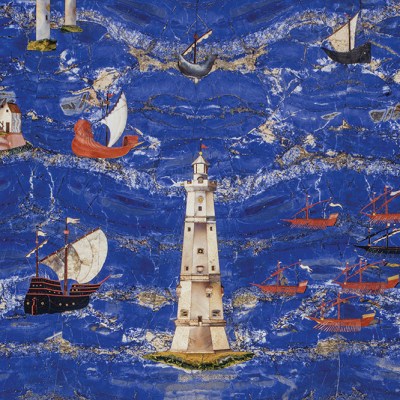From the December 2022 issue of Apollo. Preview and subscribe here.
The French aesthetic philosopher – and curious student of the ritual and sacred – Roger Caillois amassed a collection of lithic oddities left, on his death, to the Muséum national d’Histoire naturelle in Paris. Among these sliced stone treasures are green jaspers patterned like lizard skin; agate from Uruguay studded with rings like unblinking eyes; misty Chinese ‘dream stones’ with markings like inky brushwork; and marble surfaces that reveal picture landscapes of stony ruins, as if foretelling their own destiny.
In his late work The Writing of Stones (1970), Caillois pits his rational, scientific brain against the instinctive human tendency to pareidolia and pattern recognition. Looking at a slice of Tuscan limestone, he knows that certain marks are caused by fractures, that the branching forms are dendrite crystals, yet he cannot stop himself seeing a picture of a castle in the woods, complete with guards on the parapets. To make sense of the new, we reach for the familiar – our interpretative ability is coloured by what we have already seen. ‘The vision the eye records is always impoverished and uncertain,’ Caillois writes. ‘Imagination fills it out with the treasures of memory and knowledge, with all that is put at its disposal by experience, culture, and history.’
The impact of culture on interpretation comes to the fore as Caillois contemplates a fretted sheet of golden limestone. To modern eyes, the patterned grey fragments at the centre of the stone carry a picture of a man – though perhaps not one that would have been evident to our forebears, for this shattered image is recognisable as a man to those whose vision has been schooled by Cubism. In searching for a reason for the ‘unwearying and irrational zeal that makes man give a meaning to all appearances devoid of it, to look for parallels everywhere, and to create them where they do not already exist,’ Caillois imagines that our appetite for metaphor, analogy and patterns is part of some deep-rooted grasping for sense and significance. The Writing of Stones is thus a route to explore our hunger to order the world according to an underlying symbolic system, or what Caillois describes as ‘a universal syntax’.
Limestone from Tuscany, called The Portrait and collected by Roger Caillois (1913–78), illustrated in Roger Caillois, la lecture des pierres (2014; Éditions Xavier Barral). Photo: © François Farges/MNHN/Atelier EXB.

Contemplating his art without artists, Caillois questions the origins of our aesthetic cues – do we impose our idea of beauty on stone, or is it stone that furnishes our ideas of beauty? In the same period, artists engaged with non-Western sculptural traditions were having related thoughts about natural rock forms, historically prized as objects of meditation in China, Korea and Japan. Over the course of his career, Isamu Noguchi developed an appreciation for unworked stone, eventually dismissing the distinction between objects fashioned by art and nature, suggesting all that mattered was our response: ‘Call it sculpture when it moves you so.’
Artists of the current geological turn look to stones less for aesthetic cues than for perspective on time, place and human agency. Many are influenced by philosopher Jane Bennett, who describes a ‘vibrant material- ism’ in which all objects, however humble, exert a power over one another. Apparently inert stuff like stone or discarded plastic has an impact on its surroundings, the behaviour of neighbouring flora, fauna and funga, and on the fossil record to come. Vibrant mate- rialism interferes with the fatal arrogance of supposing humankind to be in control of its environment. Like Caillois’s idea of a universal syntax, it reminds us of greater forces at play.
Contemplating geological ‘deep time’, artists offer us a long view on the dispiriting chaos of our own moment. In ‘The Rock Cycle (Yamaguchi)’, recently shown at the Pier Arts Centre, Stromness, Ilana Halperin found connections between the geology of Scotland and Japan. Objects in the exhibition described a rock cycle – the evolution of calcium carbon- ate from its generation by a lifeform (coral), to become first sedimentary (limestone) and then metamorphic rock (marble). Yamaguchi is an area of geothermal activity, and Halperin treated the hot springs and geysers as co-sculptors, submerging wooden objects and pieces of crochet in the mineral-rich water, where they lithified over the course of months.
Halperin turns to geology for assistance in understanding human relations. The mineral mica from the metamorphic rock of her birth- place – New York – and also her adult home in the west of Scotland points to these locations’ shared history on the ancient continent Laurentia. Her recent book Felt Events takes its name from the description of seismic activity. In Halperin’s art, geological phenomena are invested with emotional weight.
‘I’ve always thought and felt that in death and raw catastrophe there is no place for metaphor,’ Halperin writes in Felt Events. Yet as Caillois points out, it is hard to resist embedding meaning in the stuff around us. Born in 1973, Halperin shared her 30th birthday with an eruption of the Eldfell volcano in Iceland. She has charted her mother’s dementia in the pace of a glacier’s shrinking. Conglomerate rock – a lithic jumble, bound together – has, for Halperin, become an emblem of family, biological and chosen. This metaphor she turned to in the bad times, too: all of us, lithic oddities, bound by shared catastrophe.
From the December 2022 issue of Apollo. Preview and subscribe here.



